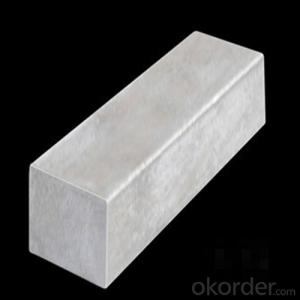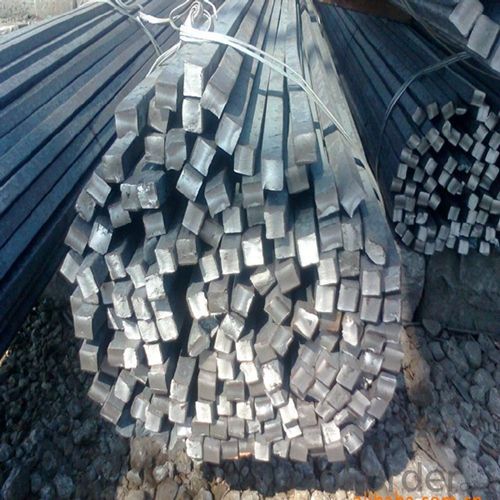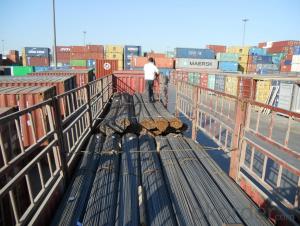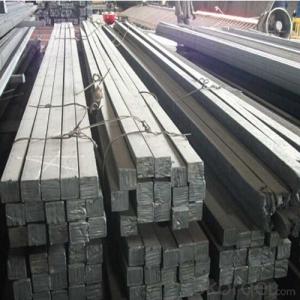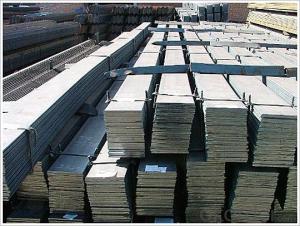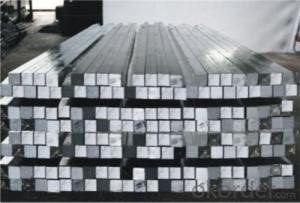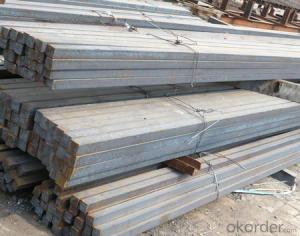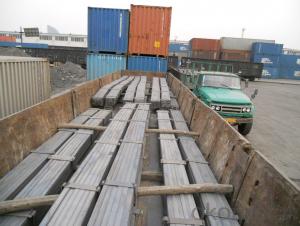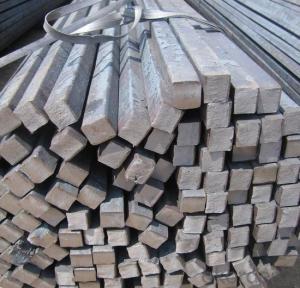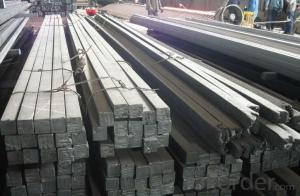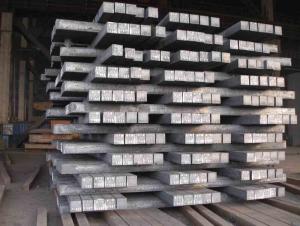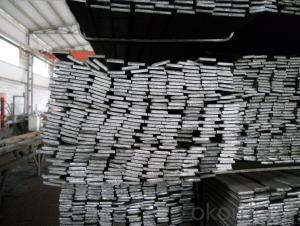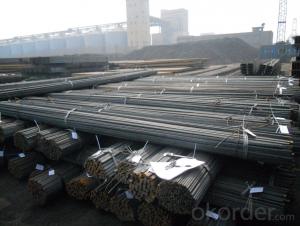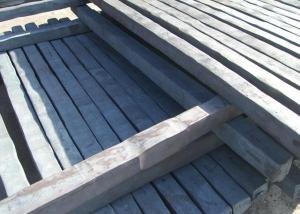Carbon Steel Square Straight Bars with Sizes 10MM to 25MM High Quality
- Loading Port:
- Tianjin
- Payment Terms:
- TT OR LC
- Min Order Qty:
- 25 m.t.
- Supply Capability:
- 1000 m.t./month
OKorder Service Pledge
OKorder Financial Service
You Might Also Like
1. Structure of Carbon Steel Square Straight Bars with Sizes 10MM to 25MM Description:
Carbon steel square straight bars with sizes 10mm to 25mm is a bar with square shaped cross-section. It is special case of equal sides. Before steel products are sold on the market, the steel must first be processed into more functional pieces. Raw steel cannot be of use while in its pure form, thus it has to be cast into shape. The freshly made steel, carbon steel square straight bars with sizes 10mm to 25mm is still in the form of a metal bar or rectangle. Small sizes of carbon steel square straight bars with sizes 10mm to 25mm are used in ship building.
2. Main Features of Carbon Steel Square Straight Bars with Sizes 10MM to 25MM:
• Grade: Q235
• Type: Mild carbon steel
• A quadrilateral with four equal sides and four right angles.
• Vibration: The stiffness and mass are chosen to prevent unacceptable vibrations, particularly in settings sensitive to vibrations, such as offices and libraries.
• Local yield: Caused by concentrated loads, such as at the beam's point of support.
3. Carbon Steel Square Straight Bars with Sizes 10MM to 25MM Images:
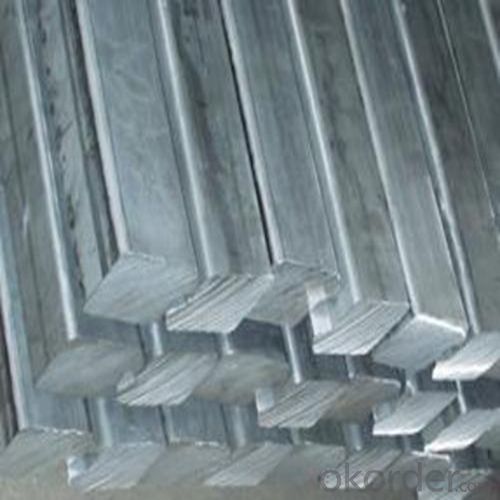
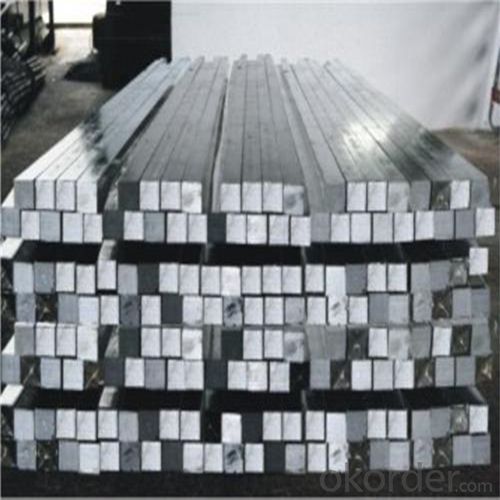
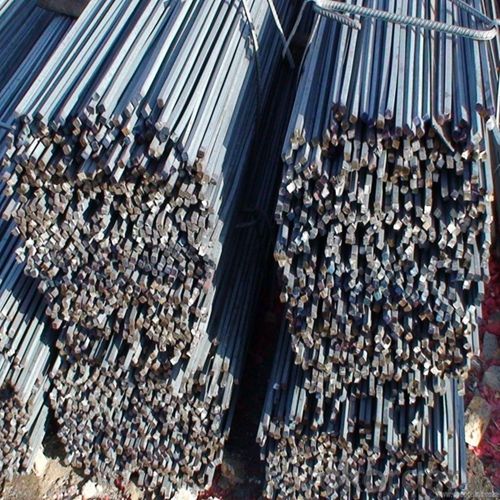
4. Carbon Steel Square Straight Bars with Sizes 10MM to 25MM Specification:
Mechanical Properties | Grade | Steel diameter(mm) | |||
≤16 | 16~40 | 40~60 | 60~100 | ||
Yield Point Δs/MPa | Q195 | ≥195 | ≥185 | - | - |
Q235 | 235 | 225 | 215 | 205 | |
Tensile Strength | Q195 | 315~390 | |||
Q235 | 375~500 | ||||
Elongation δ5% | Q195 | ≥33 | ≥32 | - | - |
Q235 | 26 | 25 | 24 | 23 | |
5. FAQ
We have organized several common questions for our clients,may help you sincerely:
①What is the main material?
There are two types of Square Bar, one is hot rolled square bar and other one is cold drawn square bar. Our principal products is hot rolled square bar. We dedicate to products with material Q195 and Q235. We offer products with high quality and low price.
②How to inspect the quality?
We have a professional inspection group which belongs to our company. We resolutely put an end to unqualified products flowing into the market. At the same time, we will provide necessary follow-up service assurance.
③Is there any advantage about this kind of product?
Steel I beam bar IPE has a reduced capacity in the transverse direction, and is also inefficient in carrying torsion, for which hollow structural sections are often preferred.
- Q: Can a steel square be used for roofing tasks?
- Yes, a steel square can be used for roofing tasks. It is a versatile tool that can be used for measuring and marking angles, cutting rafters, and laying out roof lines accurately.
- Q: How do you use a steel square to determine the angle of a routing template cut?
- To determine the angle of a routing template cut using a steel square, follow these steps: 1. Position the steel square against the edge of the routing template, making sure that the long side of the square is in contact with the template's edge. 2. Align the short side of the square with the straight edge of the desired routing template cut that you wish to measure. 3. Examine the markings on the steel square. Most steel squares have angle measurements indicated on them. Locate the angle that corresponds to the desired cutting angle. 4. Once you have identified the angle, either mark it on the routing template or remember it mentally. 5. Utilize the marked angle as a reference to adjust the routing tool to the precise cutting angle. This adjustment may involve modifying the base or guide on the router to match the desired angle. 6. Proceed with the routing procedure while ensuring that the routing tool is aligned with the marked angle on the routing template. By employing a steel square in this manner, you can ascertain the angle of a routing template cut accurately and execute the cut with great precision.
- Q: How do you use a steel square to measure stair treads and risers?
- To use a steel square to measure stair treads and risers, follow these steps: 1. Start by ensuring that your steel square is clean and in good condition. Any dents or damage may affect the accuracy of your measurements. 2. Position the steel square on the edge of the stair tread, aligning the tongue (the shorter arm) with the edge of the tread. Make sure the blade (the longer arm) is flat against the riser. 3. Hold the square firmly in place and mark the measurement on the tread. This will give you the width of the tread. 4. Next, move the square to the riser. Align the tongue with the edge of the tread and the blade with the bottom of the tread above. Again, mark the measurement on the riser. This will give you the height of the riser. 5. Repeat this process for each tread and riser, ensuring that your measurements are accurate and consistent. 6. Once you have measured all the treads and risers, check your measurements to ensure they are within the acceptable range for building codes or the project requirements. Using a steel square to measure stair treads and risers is a straightforward process that can provide accurate measurements. It is important to be precise and consistent to ensure the stairs are safe and meet the necessary standards.
- Q: What are some common uses for a steel square in box joint construction?
- A steel square is an essential tool in box joint construction and is used for a variety of purposes. Some common uses for a steel square in box joint construction include: 1. Layout and marking: A steel square is used to accurately mark and measure the dimensions of the box joint. It helps in setting up the appropriate size and spacing of the finger joints and ensures precision in the layout. 2. Checking for squareness: The steel square is utilized to check the squareness of the corners in box joint construction. This ensures that the joints are perfectly perpendicular and will result in a strong and sturdy box. 3. Aligning and guiding: When assembling the box joint, a steel square can be used to align and guide the pieces together. It helps to maintain the correct angle and ensures that the joints fit snugly, resulting in a tight and secure box. 4. Testing for flatness: The steel square can also be used to test the flatness of the joint surfaces. By placing the square against the surfaces, any gaps or irregularities can be detected and corrected before final assembly. 5. Cutting and sawing: A steel square can be used as a guide for cutting and sawing the box joint. It provides a straight edge for the saw or router, ensuring clean and accurate cuts along the joint lines. Overall, a steel square is an indispensable tool in box joint construction. It helps in layout, alignment, checking for squareness, and ensuring precision cuts, resulting in a well-fitted and strong box joint.
- Q: Can a steel square be used for retaining wall construction?
- Yes, a steel square can be used for retaining wall construction. Steel squares are versatile tools commonly used in construction for measuring and marking right angles, as well as checking for squareness and leveling. While they may not be the primary tool for constructing the wall itself, they can be useful for ensuring accuracy and precision in the construction process.
- Q: What are some common uses for a steel square in metal fabrication?
- A steel square, also known as a framing square or a carpenter's square, is a versatile tool that is commonly used in metal fabrication for a variety of purposes. Some of the common uses for a steel square in metal fabrication include: 1. Measuring and marking: A steel square is an essential tool for accurately measuring and marking metal pieces. It is particularly useful in ensuring precise angles and lines, which are crucial in metal fabrication. 2. Squaring corners: Metal fabrication often requires precise right angles and squared corners. A steel square is used to ensure that corners are perfectly square, allowing for accurate and seamless welding or joining of metal pieces. 3. Checking for flatness: Metal sheets or plates should ideally be flat and level before fabrication. A steel square can be used to check for any warping or bending in the metal surface, helping to identify and correct any imperfections before further processing. 4. Layout work: The tool's straight edges and angles are useful in layout work, which involves marking and positioning various components before assembly. Steel squares help in accurately transferring measurements and creating templates for cutting or shaping metal pieces. 5. Drafting and designing: Steel squares are often used in drafting and designing metal structures or components. They aid in creating precise drawings, making accurate calculations, and ensuring that the final product meets the required specifications. 6. Angle measurements: Steel squares are equipped with a protractor scale that allows for measuring and marking various angles. This feature is beneficial in metal fabrication, where specific angles are required for cutting, bending, or welding metal pieces. 7. Setting up machinery: Steel squares are also useful during the setup of machinery in metal fabrication workshops. They can be used to align and position machines, ensuring that they are level and accurately placed for optimal performance. Overall, a steel square is an indispensable tool in metal fabrication, providing accuracy, precision, and versatility in various tasks such as measuring, marking, squaring corners, checking flatness, layout work, drafting, designing, angle measurements, and machinery setup.
- Q: What are some common applications for a steel square in concrete formwork?
- A steel square, a tool commonly used in concrete formwork, serves various purposes. Here are some examples: 1. Precise angle measurement: Steel squares are designed with a 90-degree and a 45-degree angle, enabling accurate angle measurement in concrete formwork. This ensures the precise placement of walls, columns, and beams. 2. Checking for squareness: Steel squares are frequently used to determine if corners or edges are perfectly square. In concrete formwork, this is crucial to ensure proper alignment and prevent deformities or misalignments in the final structure. 3. Aligning and leveling formwork: Steel squares help align and level formwork components like panels, beams, and supports. Contractors can achieve plumb and level formwork by adjusting the square accordingly, resulting in a smooth concrete surface. 4. Creating straight edges: By utilizing steel squares as guides, contractors can create straight edges in concrete formwork. This guarantees a clean finish when the concrete is poured and cured. 5. Accurate measurements: Steel squares are valuable for precise measurement and marking in concrete formwork. Contractors can use them to determine the correct lengths, widths, and heights of formwork components, ensuring a precise fit and accommodating the desired dimensions of the final structure. To summarize, a steel square is an essential and versatile tool in concrete formwork. Its applications include measuring and marking angles, checking for squareness, aligning and leveling formwork, creating straight edges, and determining accurate measurements. Its versatility and accuracy make it indispensable for achieving high-quality concrete structures.
- Q: Can a steel square be used for checking the squareness of a table saw sled?
- Yes, a steel square can be used to check the squareness of a table saw sled. The straight edges of a steel square can be aligned with the edges of the sled to determine if it is perfectly square or if any adjustments need to be made.
- Q: Can a steel square be used for tile border layout?
- Indeed, tile border layout can be accomplished using a steel square. Esteemed for its multifunctionality, a steel square is frequently employed in woodworking and construction endeavors. Featuring marked measurements on its surface, this tool guarantees precision in angles and straight lines. Consequently, in the realm of tile border layout, a steel square can be utilized to denote and gauge the edges of the tiles, thus ensuring exact and unswerving cuts for the border tiles. Utilizing a steel square facilitates the attainment of an impeccable and polished tile border layout.
- Q: How do you use a steel square for marking stair tread and riser dimensions?
- To mark the dimensions of stair treads and risers using a steel square, the following steps should be followed: 1. Begin by measuring the total rise of the stairs, which is the vertical distance from the top of the landing to the finished floor level. Take note of this measurement. 2. Next, calculate the desired height of each riser by dividing the total rise by the number of risers. For example, if the total rise is 48 inches and there are 6 risers, each riser should be 8 inches high (48/6 = 8). 3. Now, place the steel square on a flat surface, ensuring that the long edge is vertical and perpendicular to the surface. 4. Align the bottom corner of the square with the edge of the material you are marking, such as a piece of wood or the stair stringer. 5. Hold the square firmly against the material and use a pencil or marking knife to draw a line along the inside edge of the square. 6. To mark the dimensions of the treads, use the inside edge of the square to measure and mark the desired depth of each tread. The tread depth can be calculated by subtracting the riser height from the desired total run (the horizontal distance covered by the stairs). For example, if you want a total run of 72 inches and there are 6 risers, each tread should be 12 inches deep (72/6 = 12). 7. Repeat this process for each riser and tread, making sure to keep the square firmly against the material to maintain accuracy. By utilizing a steel square for marking stair tread and riser dimensions, precise and consistent measurements can be achieved, resulting in well-balanced and safe stairs. Always double-check your measurements before cutting or installing any materials.
Send your message to us
Carbon Steel Square Straight Bars with Sizes 10MM to 25MM High Quality
- Loading Port:
- Tianjin
- Payment Terms:
- TT OR LC
- Min Order Qty:
- 25 m.t.
- Supply Capability:
- 1000 m.t./month
OKorder Service Pledge
OKorder Financial Service
Similar products
Hot products
Hot Searches
Related keywords
